27 GKN Jobs

Plant Supplier Quality
GKN
posted 1mon ago
Job Role Insights
Flexible timing
Key skills for the job
Job Description
Values Behaviours Ingenious : Manages complexity Makes sense of complex, high quantity, and sometimes contradictory information to effectively solve problems. For example, looks at complex issues from multiple angles; explores issues to uncover underlying issues and root causes; sees the main consequences and implications of different options.
Ingenious : Driving continuous improvement Knows the most effective and efficient processes to get things done, with a focus on continuous improvement. For example, pursues, explores, and develops ways to ensure own work is as effective as possible within all relevant processes. Shares an analysis of process problems with stakeholders; discusses how to resolve the issue.
Collaborative : Drives engagement Creates a climate where people are motivated to do their best to help the organization achieve its objectives. For example, readily includes people and ensures their efforts are recognized; seeks to learn from their success. Ensures that people understand exactly why the work is important and meaningful.
Collaborative: Builds trust: Gains the confidence and trust of others through honesty, integrity, and authenticity. For example, demonstrates integrity, upholding professional codes of conduct. Instills trust by following through on agreements and commitments despite competing priorities and by being honest and straightforward.
Collaborative: Emotional intelligence Relates openly and comfortably with diverse groups of people. For example, takes time to build rapport in meetings; speaks about common interests and priorities; shows tact and sensitivity in difficult interpersonal situations. Maintains productive relationships with a wide variety of people and from a range of backgrounds.
Principled: Accountability Holds self and others accountable to meet commitments. For example, tracks performance and strives to remain effective, learning from both successes and failures. Readily takes on challenges or difficult tasks and has reputation for delivering on commitments.
Principled: Communicates effectively Develops and delivers multi-mode communications that convey a clear understanding of the unique needs of different audiences. For example, tailors communication content and style to the needs of others. Pays attention to others input and perspectives, asks questions, and summarizes to confirm understanding.
Driven: Results driven Consistently achieves results, even under tough circumstances. For example, regularly pushes self to achieve outstanding outcomes; consistently establishes bold goals for own performance; is passionate about excellent results and significant contributions. Shows great tenacity to complete goals/initiatives in a timely way.
Driven: Prioritization Plans and prioritizes work to meet commitments aligned with organizational goals. For example, outlines clear plans that put actions in a logical sequence; conveys some time frames. Aligns own work with relevant workgroups. Takes some steps to reduce bottlenecks and speed up the work.
Skills:
Supplier Management Works without supervision and provides technical guidance when required on managing vendors so that they deliver the best possible results given available resources.
Creative Problem Solving Works with full competence to find practical solutions for unexpected client problems. Typically works without supervision and may provide technical guidance.
Policy and procedures Works without supervision and provides technical guidance when required on developing, monitoring, interpreting and understanding policies and procedures, while making sure they match organizational strategies and objectives.
Review and Reporting Applies comprehensive knowledge and skills to work independently while providing guidance and training to others on reviewing and creating relevant, lucid and effective reports.
Procurement Quality Management Works without supervision and provides technical guidance when required on the design, implementation and management of quality control systems for procurement processes.
Risk Management Identifies, assesses, prioritizes and manages risks without supervision and provides technical guidance when required.
Workflow Management Works at an intermediate level to orient work in a workflow to plan, organize, and execute the steps it takes to achieve a goal to achieve higher efficiencies. Typically works with guidance.
Project Change Management Works without supervision and provides technical guidance as required on identifying, managing and controlling project-related changes.
Education: Short-Cycle Tertiary Education
Experience: 8 to 9 years
Employment Type: Full Time, Permanent
Read full job descriptionGKN Interview Questions & Tips
Prepare for GKN roles with real interview advice
People are getting interviews at GKN through
People are getting interviews through
(based on 15 GKN interviews)
Job Portal
Campus Placement
Company Website
Walkin
Recruitment Consultant
Referral
28%
13%
13%
13%
13%
7%
13% candidates got the interview through other sources.
High
Confidence
?
High Confidence means the data is based on a large number of responses received from the candidates.
What people at GKN are saying
What GKN employees are saying about work life
based on 512 employees
Flexible timing
Monday to Saturday
No travel
Day Shift
Similar Jobs for you
Share an Interview


































